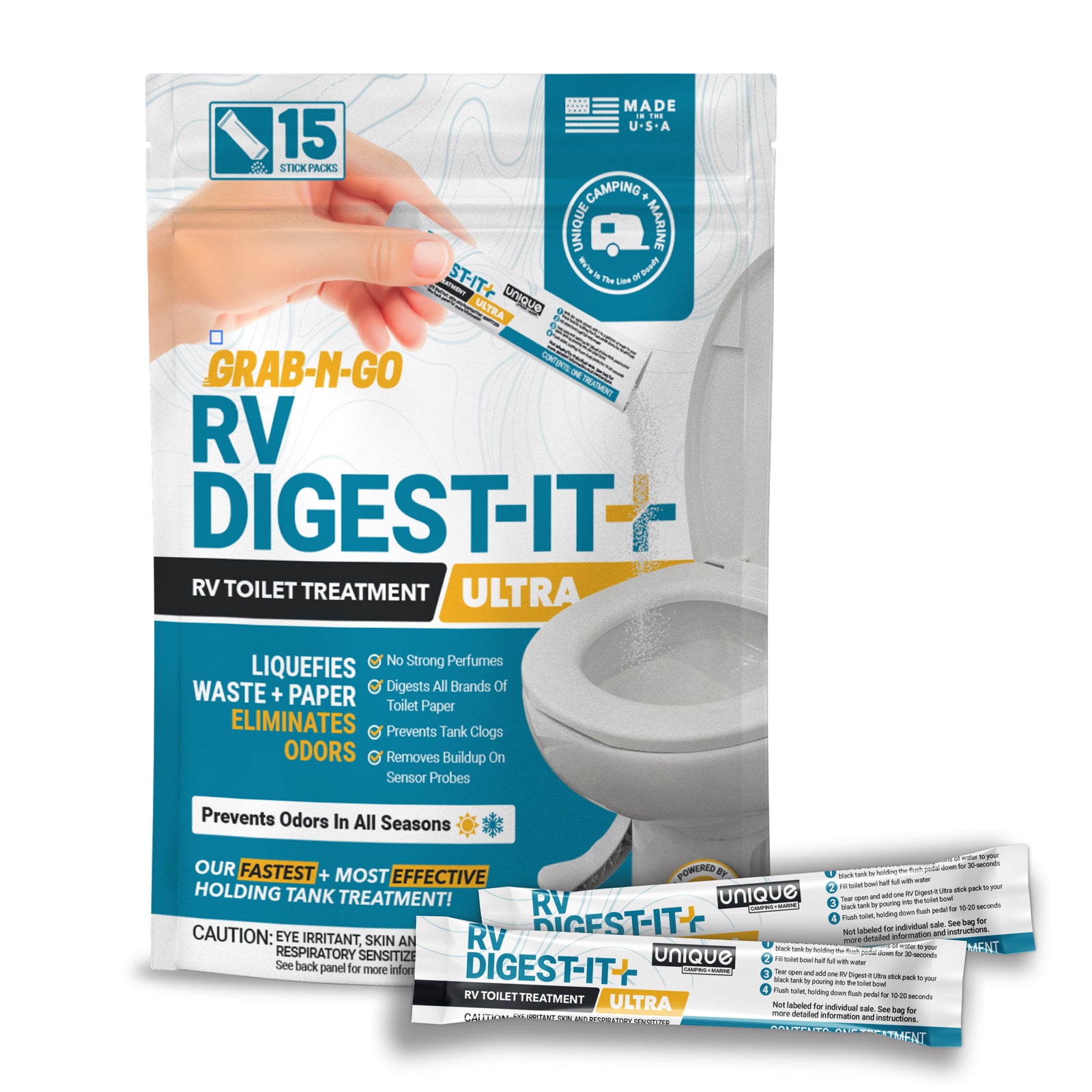
Updated 4/17/25
Key Points:
- Deep cleaning will help prevent clogs, but if you think you're experiencing a clog, use this guide.
- Steps to deep clean your black tank are simple and will help you prevent clogs and odors.
- Steps to deep clean your gray tank are simple and will eliminate odors from your sinks and drains.
- Deep cleaning should be performed twice per year at a minimum, or as problems arise.
- Common techniques and homemade treatment advice passed around the RVing community (The Geo Method, Borax, Ice and Driving, etc.) may not give you the results you want.
We get a lot of questions about the best way to clean RV holding tanks. Keeping your holding tanks clean and free from build-up is key to avoiding the clogs and foul odors that can sneak up on you while camping.
Deep cleaning your black and gray tanks should be a regular part of maintaining your RV, and when done correctly, can prevent clogs and odors from interrupting your plans.
Without regular deep cleaning, waste can find ways to hide in the crevices and low points of your tank and potentially cause problems down the line. Whether you currently have a problem or just want to practice good seasonal tank care habits, deep cleaning your tanks is a great place to start.
A Note About Clogs
If you think you might have a clog either in your tank or in your toilet right now (i.e. opening your valve and nothing is coming out), this guide will not help you remedy that problem. We recommend referring to the following guides that will help you diagnose the specific problem, how to fix that problem, and what you need to do going forward to avoid those same issues in the future:
How to Deep Clean an RV Black Water Tank
Deep cleaning your RV black tank(s) may sound pretty involved, but it’s actually quite simple.
Supplies:
- Water
- A bacteria-based cleaner (like Clean-It)
- Time
We recommend using Unique Clean-It because it’s the strongest bacteria-based cleaner on the market and will help you achieve the deepest clean outside of hiring a professional to power wash your tank. The steps below will walk you through the process of deep cleaning your RV black tank using Unique Clean-It.
- CLOSE YOUR BLACK TANK VALVE.
-
Fill your black tank completely with water.
You will know the tank is full when you start to see water backing up the pipe that connects the toilet to the black tank. -
Dump 1 entire bottle of Unique Clean-It into your 40 gallon black tank by pouring it through your toilet
and let it sit in the tank for 12-72 hours.
While Clean-It typically works in about 12 hours, the longer you let it work the better! Letting it sit for days, weeks, or even months won't cause any damage to your RV. Class B RVs and others with smaller tanks may need less than one bottle of Clean-It.
Note: No amount of Clean-It is too much, so feel free to use a whole bottle on a smaller tank or more on a larger tank. If you have questions, we are always willing to help you find the best solution for your RV. - Open your black tank valve and dump your tank.
-
Rinse your tank thoroughly.
- Do this by closing the black tank valve after the initial dump. Then fill the black tank completely full with water. You may do this by whichever means you choose (onboard tank rinser, rinse wand, or just holding down the toilet flush pedal and allowing the tank to fill with water). Then open the black tank valve and allow all of the water to flow out of the black tank. Repeat this process again for best results.
-
CLOSE YOUR BLACK TANK VALVE.
Always keep your black tank valve closed unless you’re dumping!
It’s that simple! We recommend performing a deep clean on your black tank twice per year: once at the beginning of the RVing season and once at the end, or every 5-10 dumps for full-time RVers. If your RV is stationary and rarely moves, it's a good idea to perform a deep clean like this every 60 days since waste tends to accumulate because it never or rarely sloshes around. If this doesn’t solve the problem, feel free to contact us any time and we will try to help you solve the issue.
Modified Black Tank Deep Cleaning for Full Time RVers
If you are a full-time RVer, deep cleaning tanks can be a lot trickier when you’re trying to use them at the same time. We recommend that full-time campers clean their black tank(s) regularly with Unique Clean-It (every 3-4 months) and their gray tank(s) with Dawn Ultra dish soap every week. This will help maintain properly working holding tanks and keep odors at bay.
We understand that while cleaning your black tank(s), you’ll still need to use them, so you may not be able to completely fill them with water and walk away for 2-3 days. Instead, full-time RVers should fill black tank(s) half or three quarters full with water (depending on anticipated usage), add one bottle of Clean-It per black tank (or less for smaller tanks), and continue regularly using your toilet, ideally letting the solution work for a full 72 hours before dumping.
The best option is always to deep clean without using the tanks, but even deep cleaning while using them will still help prevent buildup and other tank issues. Just remember, Clean-It can only clean areas it can reach; areas of the tank walls that are not touched by water will not be cleaned.
How to Deep Clean an RV Gray Water Tank
If you think your black tank will likely be the only culprit when it comes to unpleasant smells inside your RV, consider the odors that could rise from the kitchen sink drain. Yes, your gray or galley tank(s) can easily start to stink as a result of the build-up of soap scum, food grease, lotions, or even human hair from the shower. This can cause more than just unpleasant odors; it can also lead to misreading sensors. Thankfully, because there aren’t a lot of solids inside your gray tank (at least, there shouldn’t be), restoring your gray tank to its full glory is very easy to do; just remove the grease that has built up inside the tank!
Supplies:
- Water
- Grease-eating dish soap
- Time
From our experience with customers, the best product out there for removing gray tank grease residue is Dawn Ultra dish soap. Yeah, we know; it doesn’t seem to make sense to add more soap to a gray tank that is already coated in soap scum and grease, but it’s an awesome grease eater and doesn’t leave a residue layer like other soaps. And just like deep cleaning the black tank(s), you can let the cleaning product (Dawn Ultra dish soap) do the heavy-lifting overnight while you sleep. The steps below will walk you through the process of deep cleaning your RV gray tank using Dawn Ultra dish soap.
- Close your gray tank valve.
-
Fill your gray tank all the way to the top with fresh water.
The ultimate goal here is for water to cover all the areas you want cleaned. If your tank isn’t totally full, only the parts of the tank at or below the waterline will be cleaned. If you’re looking to restore your gray tank sensors, be sure that water covers the highest sensor in your gray tank. -
Pour at least 20 ounces (or more) of Dawn Ultra dish soap down your RV’s kitchen sink.
There is no amount of Dawn Ultra that is too much. It’s possible that you’ll see it foaming back out of your sink or shower lines (an indication you’ve poured enough Dawn Ultra into the tank), which is a good sign because it means that the grease-eating dish soap is spreading throughout your RV’s pipes and cleaning out all the built-up residue. - Let Dawn Ultra sit in the tank and P Traps overnight.
-
Open your gray tank valve in the morning and empty your gray tank.
It’s very likely that you’ll see a grayish-white residue on the bottom of your holding tank discharge pipe. This is literally the grease that was previously clinging to the inside walls of your holding tank. - Rinse your tank thoroughly by filling it completely and dumping it several times.
-
Repeat these steps if necessary.
Sometimes it can take several cleanings before the gray tank is clean inside.
Like black tanks, it’s a good idea to deep clean your gray tanks on a regular schedule, depending on what kind of camping you are typically doing.
- If you are primarily a hookup camper (and you follow our advice about gray tank valves), we recommend deep cleaning your gray tank biannually, once at the beginning of the season and once at the end.
- If you are a boondocker (dry camper), we recommend you perform a deep clean like this on the last night of every camping trip to avoid grease buildup inside your gray tank.
Routine cleaning of both your black and gray/galley tanks will help you stay on top of any waste and grease buildup that can cause your tanks to smell or your sensors to misread. If your sensors are currently misreading and you’re in need of specific guidance for restoring your tank sensors, refer to the How to Clean and Restore RV Wastewater Sensors guide.
Note: To prevent solid food waste from getting into your gray/galley tank(s), use a sink strainer to catch residual food waste and wipe grease and debris off your dishes before washing whenever possible.
Deep Cleaning an RV Black/Gray Water Combo Tank
Combo tanks can sometimes be more challenging to clean if you are using it as both a black and grey water tank. Some RVers stick to using it for only grey water or only black water. Here are a few tips about how to clean your combo tank based on how you are using it:
- If you are using your combo tank as only a black water tank, refer to the steps in the Deep Cleaning an RV Black Water Tank section above.
- If you are using your combo tank as only a gray water or galley tank, refer to the steps in the Deep Cleaning an RV Gray Water Tank section above.
- If you are using your combo tank for both gray and black water, start by cleaning it as if it were solely used as a black tank. If you think there may be ample amounts of grease or soap scum still there that were not taken care of by the black tank cleaning steps, use the gray tank cleaning steps as well.
Combo tanks aren’t hard to keep clean and if in doubt, start by using the black tank cleaning steps and then follow up with a gray tank cleaning. It never hurts to clean both ways and cover all bases.
Hire A Professional Tank Cleaning Service
Professional tank cleaning services are an excellent way to ensure that your holding tank is deep cleaned. These companies use pressure washers and specialized cleaning attachments to spray high pressure water into the black tank and remove waste and toilet paper build up that may have accumulated over the course of the camping season. Hiring one of these services is also an excellent way to reset a holding tank if you have purchased a used RV and want to ensure that the black tank is spotless. No one wants other people's poo in their holding tanks, and hiring a professional service is a great option for people who want peace of mind! Professional tank cleaning services can be a bit expensive, but for severe problems or for people willing to pay, it’s worth it. Just make sure you shop around a bit.
When Should You Deep Clean Your RV Holding Tanks?
We recommended performing a deep clean at the start and close of the camping season. That means both when you take your RV out of storage, and when you prepare to winterize. This might seem like overkill, but we have found that doing a deep clean at the beginning and end of the camping season is the most consistent way to prevent problems.
Sometimes problems can also arise during the camping season that might warrant a deep cleaning. Look for:
- Additional odor coming from the black tank while flushing the toilet.
- Misreading sensors on the black tank controller.
- Seeing waste and toilet paper build up when looking down the toilet and into the black tank.
Most, if not all of these can be avoided completely by following the Unique Method and by consistently using enough water and rinsing the black tank after each dump when possible.
Common Tank Care Advice in the RVing Community
The RVing community shares a lot of home remedies and commonly used methods to deep clean RV holding tanks, but often that advice does not pan out as well as you might think. If you are considering using some of the deep cleaning advice passed around by other RVers, we encourage you to read our article on Common RV Holding Tank Myths Debunked; the results of many of the techniques and recommended products fall short of the praise they receive.
The Unique Method will help prevent the majority of tank problems before they happen, so we recommend following this method, which recommends regular deep cleaning. For more thorough details on full-time RVing care habits, refer to this guide: Full Time RVing: The Definitive Guide To Treating Your Tank.
Review
Deep cleaning both your black and gray tanks will not only help you enjoy your RVing adventure all the more without having to deal with nasty odors or the inevitability of RV clogs, but it will also help your wastewater systems run optimally for years to come. Deep cleaning your RV wastewater tanks regularly is very important for avoiding clogs and odors in the future. Unique Camping + Marine has been helping RVers navigate their toughest wastewater problems for over 30 years and we want to help you! So if you have any questions, please don’t hesitate to contact us. We have in-house Certified RV Techs and wastewater experts for this exact reason, to help RVers!

Prevent Common Problems In Your Tanks!
From misreading sensors, preventing clogs, or eliminating odors, we've got you covered no matter how you camp! All our best holding tank tips and trick information plus more can be found conveniently in one place when you download our FREE Unique Method Field Guide PDF. Achieve holding tank bliss today!
Get The Free Download Get The Free Download



